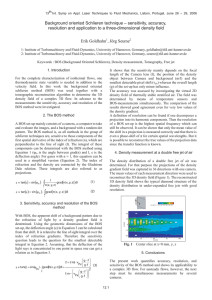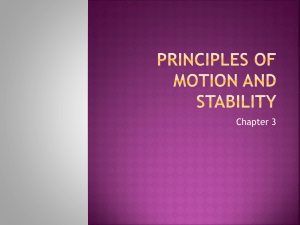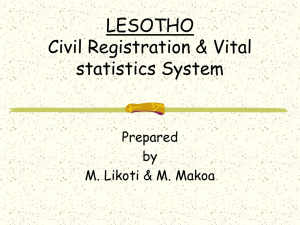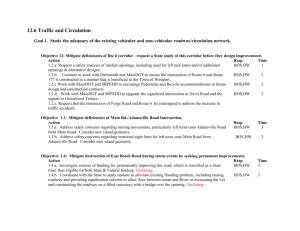Document 10549553
advertisement
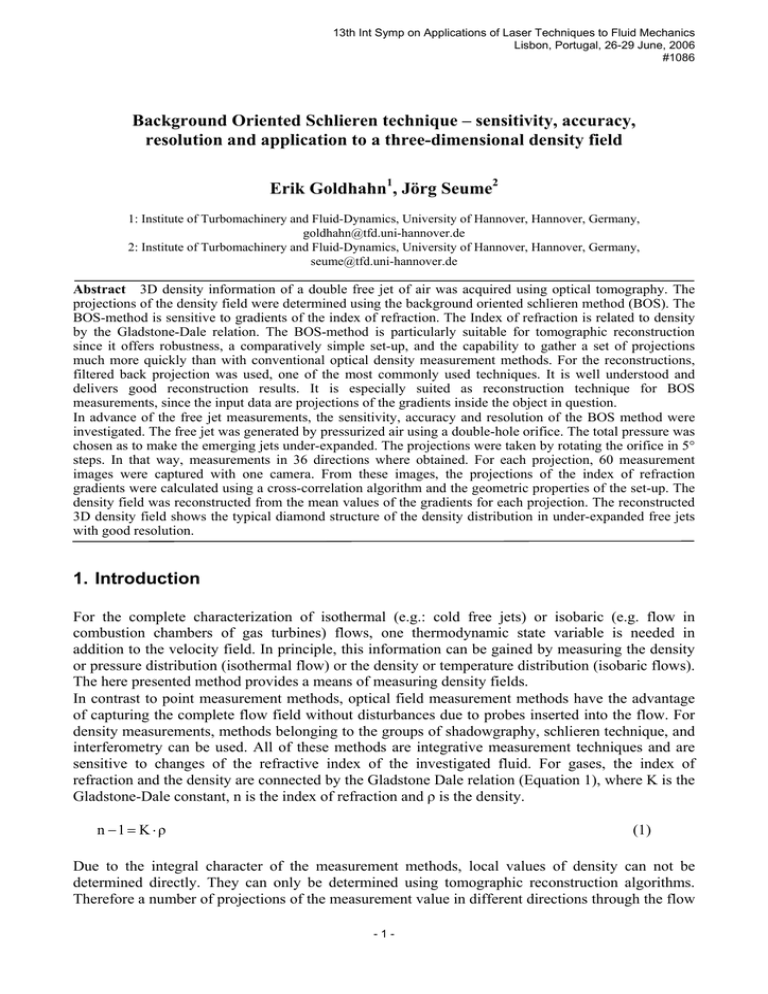
13th Int Symp on Applications of Laser Techniques to Fluid Mechanics
Lisbon, Portugal, 26-29 June, 2006
#1086
Background Oriented Schlieren technique – sensitivity, accuracy,
resolution and application to a three-dimensional density field
Erik Goldhahn1, Jörg Seume2
1: Institute of Turbomachinery and Fluid-Dynamics, University of Hannover, Hannover, Germany,
goldhahn@tfd.uni-hannover.de
2: Institute of Turbomachinery and Fluid-Dynamics, University of Hannover, Hannover, Germany,
seume@tfd.uni-hannover.de
Abstract 3D density information of a double free jet of air was acquired using optical tomography. The
projections of the density field were determined using the background oriented schlieren method (BOS). The
BOS-method is sensitive to gradients of the index of refraction. The Index of refraction is related to density
by the Gladstone-Dale relation. The BOS-method is particularly suitable for tomographic reconstruction
since it offers robustness, a comparatively simple set-up, and the capability to gather a set of projections
much more quickly than with conventional optical density measurement methods. For the reconstructions,
filtered back projection was used, one of the most commonly used techniques. It is well understood and
delivers good reconstruction results. It is especially suited as reconstruction technique for BOS
measurements, since the input data are projections of the gradients inside the object in question.
In advance of the free jet measurements, the sensitivity, accuracy and resolution of the BOS method were
investigated. The free jet was generated by pressurized air using a double-hole orifice. The total pressure was
chosen as to make the emerging jets under-expanded. The projections were taken by rotating the orifice in 5°
steps. In that way, measurements in 36 directions where obtained. For each projection, 60 measurement
images were captured with one camera. From these images, the projections of the index of refraction
gradients were calculated using a cross-correlation algorithm and the geometric properties of the set-up. The
density field was reconstructed from the mean values of the gradients for each projection. The reconstructed
3D density field shows the typical diamond structure of the density distribution in under-expanded free jets
with good resolution.
1. Introduction
For the complete characterization of isothermal (e.g.: cold free jets) or isobaric (e.g. flow in
combustion chambers of gas turbines) flows, one thermodynamic state variable is needed in
addition to the velocity field. In principle, this information can be gained by measuring the density
or pressure distribution (isothermal flow) or the density or temperature distribution (isobaric flows).
The here presented method provides a means of measuring density fields.
In contrast to point measurement methods, optical field measurement methods have the advantage
of capturing the complete flow field without disturbances due to probes inserted into the flow. For
density measurements, methods belonging to the groups of shadowgraphy, schlieren technique, and
interferometry can be used. All of these methods are integrative measurement techniques and are
sensitive to changes of the refractive index of the investigated fluid. For gases, the index of
refraction and the density are connected by the Gladstone Dale relation (Equation 1), where K is the
Gladstone-Dale constant, n is the index of refraction and ρ is the density.
n −1 = K ⋅ ρ
(1)
Due to the integral character of the measurement methods, local values of density can not be
determined directly. They can only be determined using tomographic reconstruction algorithms.
Therefore a number of projections of the measurement value in different directions through the flow
-1-
13th Int Symp on Applications of Laser Techniques to Fluid Mechanics
Lisbon, Portugal, 26-29 June, 2006
#1086
field must be taken. There are a number of studies regarding optical tomography in combination
with classical density measurement methods (especially schlieren techniques and interferometry) [1,
2]. The experimental complexity as well as the effort needed to evaluate the measurements is very
high for these methods. In contrast, the BOS method offers the possibility to take and evaluate
projections from different viewing directions easily. It is even possible to capture different
projection directions simultaneously using one camera for each direction.
2 The BOS method
2.1 Measurement principle
A BOS setup mainly consists of a camera, a computer to take and evaluate the images, and a
background with a random dot pattern. The BOS method is, as all methods in the group of schlieren
techniques are, sensitive to those components of the first spatial derivative of the index of
refraction, which are perpendicular to the line of sight. The integral of these components along the
line of sight can be determined with the BOS method using Equation 2. For gases with n ≈ 1, this
equation can be used in a simplified version (Equation 3).
ε ≈ tan (ε ) = sin (ϕ ln ) ⋅ ∫
l
1
grad{n ( x , y, z)}dl
n ( x , y, z )
(2)
ε ≈ tan (ε ) = sin (ϕ ln ) ⋅ ∫ grad{n ( x , y, z)}dl
(3)
l
Were l is the coordinate along the line of sight, ε is the deflection angle, φln is the angle between the
line of sight and the direction of the vector of the index of refraction gradient, and n is the spatial
distribution of the index of refraction.
Background
(CCD-sensor plane)
ε
l
∆y
n(x,y,z)
y
∫ grad(n(x, y, z))
φln
r
l
Fig. 1 BOS set-up (schematic)
Variations of the index of refraction which are connected to density by the Gladstone-Dale relation
(Equation 1) cause an apparent shift of the background dot pattern (∆y in Figure 1). With the aid of
cross-correlation algorithms these shifts can be evaluated by the comparison of a reference image
(without flow) with a measurement image (with flow). From these shifts the deflection angles (as in
Equation 2) of the light rays’ through the flow can be calculated using the geometric proportions of
the setup [3, 4]. In contrast to classical optical density measurement methods, BOS features a
-2-
13th Int Symp on Applications of Laser Techniques to Fluid Mechanics
Lisbon, Portugal, 26-29 June, 2006
#1086
simple setup, robustness, and independence of accurate intensity measurements. Therefore it is
especially suited for quantitative investigations. It can be used for the investigation of density fields,
but also temperature, pressure, and concentration fields can be determined if in the first case the
pressure, in the second case the temperature, and in the third case pressure and temperature are
known inside the field. Beside visualizations, some quantitative investigations of two-dimensional
flows and flows with rotational symmetry have been carried out with BOS so far [5, 6].
2.1 Sensitivity
Measurements using the BOS method are integral measurements. With BOS, the apparent shift of a
background pattern due to the refraction of light by a density gradient field is determined. Using the
geometric dimensions of the set-up, the deflection angle ε in Equation 3 can be calculated from that
shift. It is related to the line of sight integral over the index of refraction gradients. Therefore the
sensitivity question leads to the question for the smallest detectable integral in Equation 3.
tan( ε) =
(1 + l m) ⋅ tan(α)
l m − tan 2 (α)
(4)
tan(α) =
vH
g
(5)
v
H
=
v
px
M
g
M = − 1
f
(6)
−1
(7)
Since the exact light path is dependent on the object under investigation and usually unknown,
simplifications must be made in order to get information about the sensitivity of a certain set-up. By
concentrating the deflection of the light to one point in space, one becomes the geometric relations
as in Figure 2 (shown for one component of the index of refraction gradient). From that the
Equation 4 for the tangent of the deflection angle can be gained. By using Equation 4 together with
Equation 5, the apparent background shift (Equation 6), the magnification (Equation 7), and the
Gladstone-Dale equation (Equation 1), one gets the relation as in Equation 8. Here f is the focal
length of the lens, M is the magnification factor, vH is the shift of the dots on the background, and
vPx is the corresponding pixel shift on the sensor-chip of the camera.
-3-
13th Int Symp on Applications of Laser Techniques to Fluid Mechanics
Lisbon, Portugal, 26-29 June, 2006
#1086
vH
ε
α
0.1px
z
m
l
y
g
Fig. 2 Geometry for the sensitivity estimation
Dependent on the parameters focal length of the lens, position of the object in the set-up, overall
size of the set-up, and smallest detectable pixel shift, it is possible to estimate the sensitivity. While
the geometric properties are dependent on the set-up, the smallest detectable pixel shift is dependent
on the set-up as well as on the evaluation algorithms. Since the background dot pattern can be
matched in pixel size and pixel density to a certain set-up, it is possible to detect pixel shifts as
small as 0.1 pixels with the available cross correlation algorithms.
0
0.05
∂n
∫ ∂y dz
,2
l= 0
m/ 0 ,5
l=
m/
0.1
5
1000
0.15
2000
l=2
m/
4000
300
200
]
mm
g[
3000
5000
f [mm 100
]
Fig. 3 Sensitivity for three different positions of the density object between camera and
background (Diagram drawn for a smallest detectable pixel size of 0.1 px)
Figure 3 shows the smallest detectable line of sight integral over the index of refraction gradient for
three positions of the density object between camera and background. The smallest detectable pixel
shift was set to 0.1 px. The sensitivity rises with larger focal length as well as with a position of the
object closer to the camera. In Contrast, the overall length of the setup plays a minor role. That
-4-
13th Int Symp on Applications of Laser Techniques to Fluid Mechanics
Lisbon, Portugal, 26-29 June, 2006
#1086
means, to a certain extent, that it is possible to adapt the sensitivity to the necessities of the
measurement task.
g −f
(1+ l m) ⋅ vPx
g ⋅ f
ε ≈ tan(ε) = sin(ϕln ) ⋅ ∫ grad(n(x, y, z))dl =
2
g − f
l
l m − vPx
⋅
g
f
(8)
2.2 Accuracy
For the assessment of the accuracy of the BOS method, the density field of thermally stable
stratified air was investigated. The set-up consisted of a glass box with the size of 400 mm by 400
mm by 400 mm. It was insulated at four sides and allowed optical access through the two sides
remaining uninsulated. The glass box was electrically heated from the top in order to establish
stable temperature stratification. The maximum heating power was 70 W. The maximum
temperature gradient achievable with that set-up was 0.1 K/mm. The thermal boundary layer at the
front and rear glass plate had a thickness of approximately 2 mm.
Position of the temperature
sensors
Density gradient from the
schlieren method
Density gradient from the
temperature measurements
2.5E-03
2.0E-03
1.5E-03
∂ρ
∂x
kg
m³ ⋅ mm
1.0E-03
5.0E-04
0.0E+00
0
25
50
[mm]
xx [mm]
75
100
Fig. 4 Density distribution from BOS- and Temperature measurements
That way one gets a two-dimensional density gradient field, which is static and can be measured by
means of temperature sensors. Therefore, the glass box was equipped with 8 temperature sensors to
determine the temperature profile simultaneously with the BOS measurements. The temperature
readings of the temperature sensors were fitted by means of a spline function. From that function,
the density gradients were calculated using Equation 9 where R is the gas constant, p is the
pressure, and x is the coordinate perpendicular to the heated cover plate. The accuracy of the
-5-
13th Int Symp on Applications of Laser Techniques to Fluid Mechanics
Lisbon, Portugal, 26-29 June, 2006
#1086
temperature sensors for relative temperature measurements was ± 0.1 K. With that accuracy, the
kg
maximum errors for the calculation of the density gradient amounts to ± 1 ⋅ 10 - 4 3
.
m ⋅ mm
∆ρ(x) R ∆T(x)
=
∆x
p ∆x
(9)
Assuming a two-dimensional density distribution, the density gradients were calculated from the
BOS data and compared to the gradients calculated from the temperature readings. The comparison
shows good agreement (Figure 4). It also shows that the accuracy of the BOS measurement is
within the error margin of the temperature sensors, even for very low values of the density gradient.
2.3 Resolution
With BOS measurements, one obtains two-dimensional projections of the three-dimensional field of
the index of refraction gradient. The information is contained in the apparent shift of the
background pattern of the measurement image compared to the reference image. These projections
are a continuous function of the projection coordinates. Therefore, it is not possible to distinguish
between single objects as it is common in optics. But a definition of resolution can be found if one
decomposes a projection into its harmonic components. Then the resolution of a BOS set-up is the
highest spatial frequency which can still be observed with the BOS system. It is therefore necessary
to know the transfer function of the system. As described above, the information about the line of
sight integral over the index of refraction gradients is contained in the apparent shift of the
background pattern. This shift is calculated using cross-correlation algorithms. These algorithms are
based on the recognition of the background intensity distribution in small areas (interrogation
windows) in the reference and measurement images. The interrogation windows contain a limited
number of randomly distributed dots. Therefore, strictly speaking, the shift calculated by cross
correlation algorithms is an intensity-weighted mean shift per interrogation area. Considering the
random overall distribution of the dots in the images, one can assume that the shift is averaged over
the interrogation window size and overlaid with a certain amount of noise due to the distribution of
the dots inside each interrogation window. With this assumption, it is possible to find a description
for the transfer function of a BOS-evaluation.
Equation 10 describes the evaluation process for the apparent background shift using cross
correlation with rectangular interrogation windows. Equation 11 describes the window function.
Equation 10 is equal to the two-dimensional convolution of the window function with the
projections of the index of refraction gradients. In the Fourier space, this convolution equals the
multiplication of the Fourier transform of the projections with the Fourier transform of the window
function.
∂ρ ∂ρ
1
+
(
x
,
y
)
= 2
∂x ∂y
mean h
y
x
∫ ∫
y−h x −h
∂ρ ∂ρ
+
( x ' , y' ) ⋅ ∏( x − x ' , y − y' )dx 'dy'
∂x ∂y
1 für x ≤ h ∧ y ≤ h
∏ ( x , y) =
0 für x > h ∨ y > h
(10)
(11)
Therefore the transfer function of the BOS evaluation equals the amplitude spectrum of the window
function. It influences the amplitude as well as the phase angle of the spatial frequencies of the
-6-
13th Int Symp on Applications of Laser Techniques to Fluid Mechanics
Lisbon, Portugal, 26-29 June, 2006
#1086
decomposed shift distribution. Figure 5 shows the transfer function for the amplitudes if rectangular
interrogation windows are used.
-3/h
-2/h
-1/h
0
1/h
2/h
3/h
-3/h
-2/h
-1/h
0
1/h
2/h
3/h
Fig. 5 Absolute Value of the transfer function of the BOS system
That means only the mean value of the shift in a projection is measured correctly. With spatial
wavelengths of the density gradient variations approaching natural multiples of the interrogation
window size, the value of the transfer function diminishes down to zero. In between, the amplitudes
corresponding to certain wavelengths of the decomposed projection are measured smaller than the
real values. Figure 6 shows the transfer function for one frequency component including the sign. It
can be seen that there is even a phase shift of π for wavelengths according to Equation 12, where λ
is the wavelength.
2n + 1
2n + 2
<λ<
h
h
(12)
n∈N
This seems to be a major drawback of the method. But it is possible to reconstruct the true values of
the projection data since the transfer function is known. The only exceptions are the values where
the transfer function is zero.
For the measurements at the free jet, which are described later, the effect of filtering by evaluating
the projections with cross correlation was not strong enough to influence the result significantly.
This is due to the fact that in this case the amplitudes of higher spatial frequencies diminish rapidly,
approaching nearly zero long before the first null in the transfer function is reached.
-7-
13th Int Symp on Applications of Laser Techniques to Fluid Mechanics
Lisbon, Portugal, 26-29 June, 2006
#1086
Fig. 6 transfer function for one frequency component
3 Density measurement at a double free jet of air
3.1 Experimental set-up
An under-expanded free jet of air is investigated. To create the jet, a simple double-hole orifice is
used (Figure 7). The orifice is mounted on a pre-chamber equipped with rectifier screens for flow
quality enhancement. The orifice is turnable after loosening 4 screws. It is equipped with an angular
scale which allowed exact adjustment of the rotation angle in 5° steps. The holes have diameters of
5 mm and 15 mm, respectively. The center distance of the holes is 13 mm.
settling chamber cap
fillet
ø
15
4.5
13
ø
7
R1
0
5.5
14
26
Fig. 7 Sketch of the double hole orifice
The pre-chamber is equipped with a pressure tapping for total pressure and a sensor for total
temperature. Both values are taken together with the BOS measurements. Both, the cameras and the
-8-
13th Int Symp on Applications of Laser Techniques to Fluid Mechanics
Lisbon, Portugal, 26-29 June, 2006
#1086
background are supported by a stiff aluminum structure. The background is illuminated by a flash
lamp, which is triggered together with the camera. The shutter time is set to 5 µs. The total pressure
in the pre-chamber is held constant at 2.5 bars. With that set-up, 36 measurement directions are
captured with one camera. In each direction, 60 measurement images are taken. With the mean
values averaged over the 60 measurement images, the three-dimensional density field is determined
using tomographic reconstruction.
3.2 Tomographic reconstruction
The filtered back-projection algorithm was used for the reconstructions. The 3D density field was
reconstructed in planes perpendicular to the jet axis. Parallel projection was assumed since the
maximum opening angle of the used camera-lens combination was ±4° and the free jet extended
only over approximately ±2°.
The reconstruction is done by convolving the projections with a filter (Equation 14) and back
projecting the result into the reconstruction area (Equation 13).
π
∫ q(s) ∗ ε (s,θ)dθ
n(x,y) =
(13)
s
0
∞
∫ Q(k)e
where q(s) =
i 2 πks
dk
(14)
−∞
k
Q(k) =
(15)
i 2 πk
y
20
x
z
rho [kg/m³]: 1.24 1.38 1.54 1.68 1.82 1.89
1.24
1.24
10
1.84
y [mm]
with
1.24
1.82
1.79
1.38
1.34
1.68
1.49
1.49
1.68
1.58
1.54
1.49
1.49
0
-10
-20
1.24
25
50
z [mm]
Fig. 8 Center slice at x=0 mm, y, z
-9-
75
100
13th Int Symp on Applications of Laser Techniques to Fluid Mechanics
Lisbon, Portugal, 26-29 June, 2006
#1086
Doing so, one gets the index of refraction distribution in the first place. From the Gladstone-Dale
relation, one can now calculate the density distribution. As a result of the tomographic
reconstruction, one obtains a measurement volume, which contains the three-dimensional density
distribution inside the free jet. The reconstruction planes are spaced 0.075 mm apart from each
other while the distance between data points inside each plane is 0.3 mm. Figure 8 shows a slice
along the jet axis at position x = 0 mm. The jet is under-expanded and shows the density
fluctuations which are typical for this type of flow.
Figure 9 shows the density distribution in the core of the bigger jet along the z-coordinate at x = 0
mm and y = 4.5 mm. Assuming isentropic conditions, it is possible to calculate the density at the
nozzle exit to be 1.93 kg/m³. The measured density amounts to 1.85 kg/m³ which is 4% lower than
from the isentropic calculation expected. However it should be pointed out, that the values directly
adjacent to the nozzle exit are disturbed by the shadow which the nozzle casts on the images. This
disturbance can be seen in Figure 8 and Figure 9.
1.8
rho [kg/m³]
1.7
1.6
1.5
1.4
1.3
0
25
50
z [mm]
75
100
Fig. 9 Density at x=0 mm, y=4,5 mm, z
4 Conclusions
The background oriented schlieren method has been used together with a tomographic
reconstruction algorithm to determine the density distribution in a under-expanded free jet of air out
of a double hole orifice. The projections of the density field in 36 directions are taken with one
camera. The reconstruction is done using filtered back projection and the mean values of the density
field in each projection direction. The reconstructed 3D density field shows the typical diamond structure
of the density distribution in under-expanded free jets with good resolution.
The properties of the background oriented schlieren (BOS) method regarding sensitivity, accuracy
and resolution are investigated. The sensitivity depends mainly on the focal length of the camera,
the position of the density field between camera and background, and the smallest detectable pixel
shift. For the assessment of the accuracy of the BOS method, the density field of thermally stable
stratified air was investigated. The measurements carried out with the BOS method show good
- 10 -
13th Int Symp on Applications of Laser Techniques to Fluid Mechanics
Lisbon, Portugal, 26-29 June, 2006
#1086
agreement with the measurements using temperature sensors. The comparison also shows that the
accuracy of the BOS measurement is within the error margin of the temperature sensors, even for
very low values of the density gradient. The resolution of the BOS method is described by its
transfer function. The transfer function is determined assuming that the apparent pixel shift is
averaged over the interrogation window size. Analysis shows that only the mean value of the shift
in a projection is measured correctly. But it was possible to reconstruct the true values of the
projection data since the transfer function is known.
The present work quantifies accuracy, resolution, and sensitivity of the BOS method and shows its
applicability to a complex 3D flow. For unsteady flows, however, the next step must be
simultaneous measurements by several cameras.
5 Literature
[1] St. R. Rotteveel: Optische Tomographie zur Untersuchung von Zylinderinnenströmungen. VDI
Reihe 6 Nr. 278, S. 50 ff Düsseldorf: VDI Verlag, 1992
[2] G. N. Blinkov, N. A. Fomin, M. N. Soloukhin, D. E. Vitkin, N. L. Yadrevskaya: Specle
tomography of a gas flame. Experiments in Fluids 8, S. 72 ff Springer Verlag, 1989
[3] F. Klinge (2001): Investigation of Background Oriented Schlieren (BOS) towards a quantitative
density measurement system. Project report 2001-19, von Karman Institute for Fluid Dynamics,
2001
[4] H. Richard, M. Raffel, M. Rein, J. Kompenhans, G.E.A. Meier: Demonstration of the
applicability of Background Oriented Schlieren (BOS). 10. Int. Symp. on Appl. of laser
techniques to fluid mechanics, Paper 15.1, Lisbon, 2000
[5] T. Kirmse: Weiterentwicklung des Messsystems BOS (Background Oriented Schlieren) zur
quantitativen Bestimmung axialsymmetrischer Dichtefelder. DLR-IB 224-2003 A 01, DLRGöttingen, 2003
[6] L. Venkatakrishnan: Density measurements in an axissymmetric underexpandet jet using
Background Oriented Schlieren technique, 24 AIAA Aerodynamic Measurement Technology
and Ground Testing Conference, Paper AIAA 2004-2603, Portland, Oregon, 2004
- 11 -
